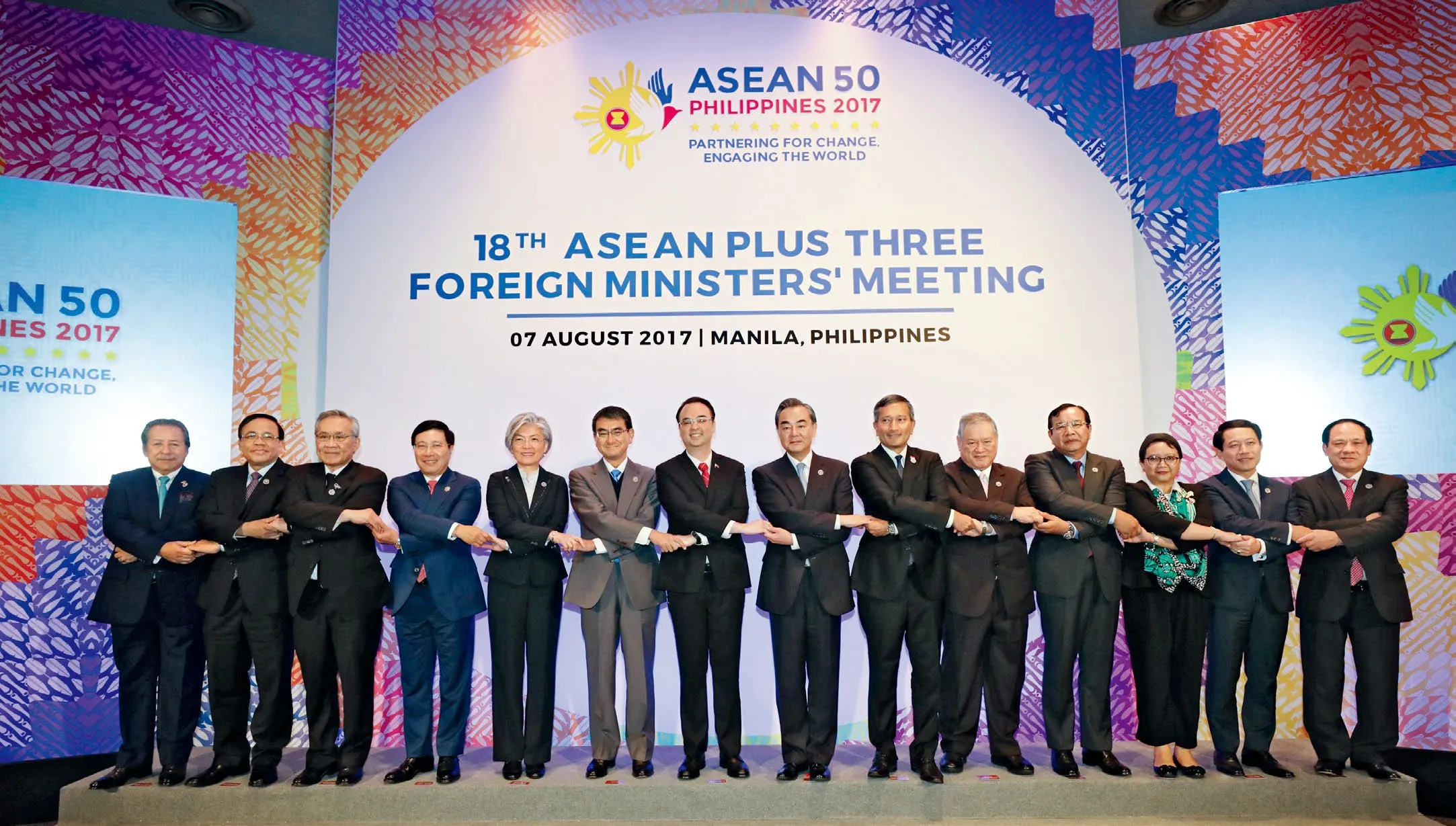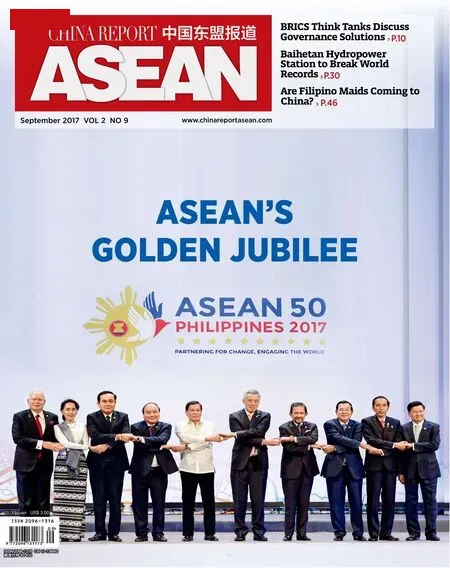GOOD NEIGHBORLINESS A TREASURE TO BE CHERISHED
By Xu Ningning
GOOD NEIGHBORLINESS A TREASURE TO BE CHERISHED
By Xu Ningning
Age-old phrase encapsulates an era of positive China-ASEAN relations

Chinese Foreign Minister Wang Yi (7th right) links arms with other foreign ministers at the 18th 10+3 Foreign Ministers’Meeting in Manila on August 7.
ASEAN and China have long been close neighbors. This year marks the 50th anniversary of the founding of ASEAN. The history of ASEAN over the past 50 years and the long-term development of ASEAN-China relations have proven the principle that “Good neighborliness is a treasure to be cherished”.
ASEAN’s Success in Solidarity
ASEAN is a success story of regional intergovernmental organizations. It has formulated a blueprint for ASEAN Community building, which is being implemented. It has striven to enhance the cohesion of the organization and promote economic growth, social development and regional stability by pushing forward interconnectivity and cooperation.
In its external relations, ASEAN is actively carrying out foreign cooperation. With mechanisms such as 10+1, 10+3 and the East Asia Summit, ASEAN has tried to take a central role in regional cooperation. It is negotiating with six non-ASEAN states (China, Japan, South Korea, Australia, New Zealand and India) on the building of a mega free trade area known as the Regional Comprehensive Economic Partnership (RCEP). It is actively developing cooperative relations with the United States, Russia, the European Union, Latin America and seeking a bigger role in international affairs. So far, 86 countries have accredited ambassadors to ASEAN. Nine of its 11 dialogue partners have set up diplomatic missions in ASEAN. Fifty ASEAN Committees in Third Countries and International Organizations (ACTC) have been set up in third countries.
At 50, ASEAN countries are summing up the experience of cooperation and development over the years and making joint efforts to build a community of sustained growth and political stability with an importantpart to play on the world stage. ASEAN is fully aware that to achieve the development goals, on the one hand, it has to be strong and united internally; on the other hand, it has to gain the support and cooperation of other countries and regions externally, and rise in “the ASEAN way”.
In 2017, ASEAN will push for six thematic priorities, including a people-oriented and peoplecentered ASEAN, peace and stability in the region, maritime security and cooperation, inclusive innovation and growth, ASEAN resilience and ASEAN as a model of regionalism and a global player.
By the end of 2016, 35 countries had acceded to theTreaty of Amity and Cooperation in Southeast Asia.
Friendly Ties of Mutual Assistance
China has always followed the foreign policy of goodneighborliness and friendship, and regarded ASEAN as a priority in its neighborhood diplomacy over the last 25 years. China assisted Southeast Asian countries to overcome the Asian financial crisis of 1997, and sought common development through cooperation by opening up markets to one another. China also proposed and implemented the initiative of jointly building the 21st Century Maritime Silk Road. All of the above reflect its sincerity in cooperation, which is rooted in the generationsold cultural belief that “Good neighborliness is a treasure to be cherished”. This sincerity has not changed with an everchanging world, nor has it been abandoned with the interference of other parties.
This year marks the 20th anniversary of the 1997 financial crisis, a disastrous crisis which taught the value of another ancient saying — “Prosperity makes friends, adversity tries them”. China did much to assist Southeast Asian countries during that period of crisis.
In 2003, China and ASEAN member states released theJoint Declaration on China-ASEAN Strategic Partnership for Peace and Prosperity. After that, the two sides formulated and implementedAction Plan to Implement the Joint Declaration 2005-2010 and Action Plan 2011-2015. At present, we are in the process of implementingAction Plan 2016-2020. Cooperation between the two sides has been continuously improved and deepened.
As is known to all, there have been a number of “firsts”in China-ASEAN cooperation. For example, the China-ASEAN Free Trade Area was the first FTA that both China and ASEAN had established with an external partner. China was ASEAN’s first external strategic partner, and China was the first to accede to theTreaty of Amity and Cooperation in Southeast Asia. All the “firsts” are evidences of the courage to innovate, which injects impetus into further cooperation. After those “firsts”, South Korea, Japan, India, the United States and other countries followed suit in their relations with ASEAN. ASEAN has thus gained ground and grown stronger.
What needs to be emphasized is that China was the first country in the world to support ASEAN in playing a leading role in regional cooperation. In recent years, ASEAN's economic growth and stability, its higher position in regional cooperation and its growing role in international affairs are associated with the unwavering support of China.
On Aug. 6, at the China-ASEAN Foreign Ministers' Meeting, the Chinese side put forward a seven-point proposal on future China-ASEAN cooperation. The proposals are as follows: First, to formulate a 2030 Vision for China-ASEAN Strategic Partnership as a blueprint to guide future relations. Second, to synergize the Belt and Road Initiative and the Master Plan on ASEAN Connectivity, and further expand the scope and dimension for bilateral cooperation. Third, to designate 2018 as China-ASEAN Year of Innovation, give full play to the complementarity of innovation-driven development of China and innovationdriven growth of ASEAN, and launch the upgrading of China-ASEAN cooperation. Fourth, to accelerate the implementation of the outcomes on upgrading the China-ASEAN Free Trade Area and jointly safeguarding global free trade. Fifth, to fully implement the China-ASEAN Joint Statement on Production Capacity Cooperation and boost each other's industrialization processes. Sixth, to build new pillars for people-to-people exchanges and cooperation, ensure the success of the China-ASEAN Tourism Cooperation Year, and issue a joint statement on tourism cooperation so as to consolidate public support and social foundation for bilateral relations. Seventh, to expedite negotiations on the Regional Comprehensive Economic Partnership and lead the process of regional integration together.
China has always followed the foreign policy of good-neighborliness and friendship, and regarded ASEAN as a priority in its neighborhood diplomacy over the last 25 years.
35
By the end of 2016,35 countrieshad acceded to the Treaty of Amity and Cooperation in Southeast Asia
86countries
haveaccredited ambassadorsto ASEAN
Nineof ASEAN's11dialogue partners have set up diplomatic missions in ASEAN
FiftyASEAN Committees in Third Countries and International Organizations (ACTC) have been set up in third countries
About the author:
Xu Ningningis the executive president of the China-ASEAN Business Council.

